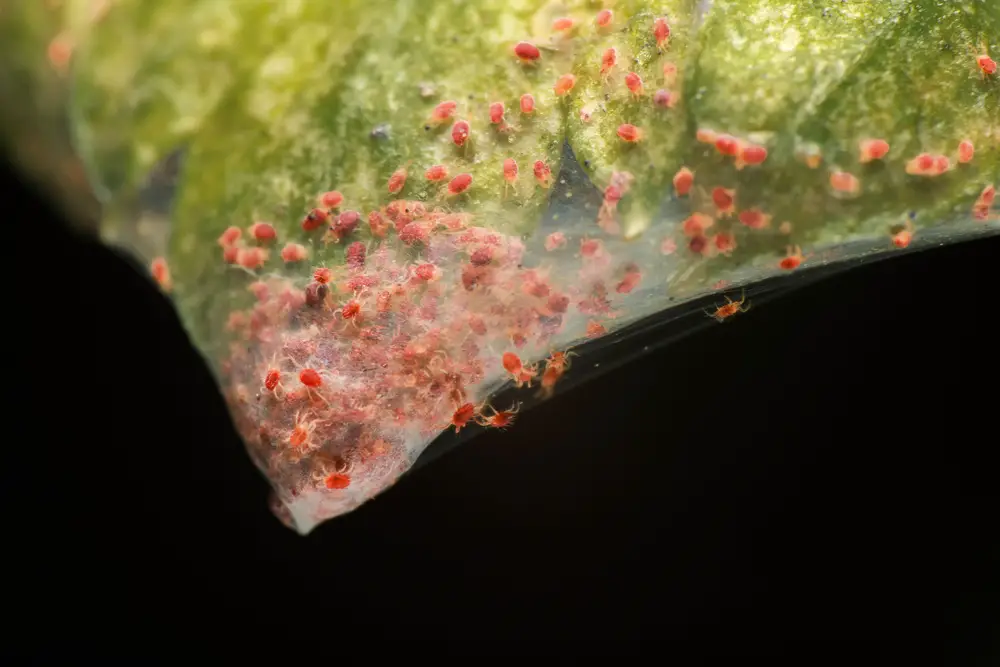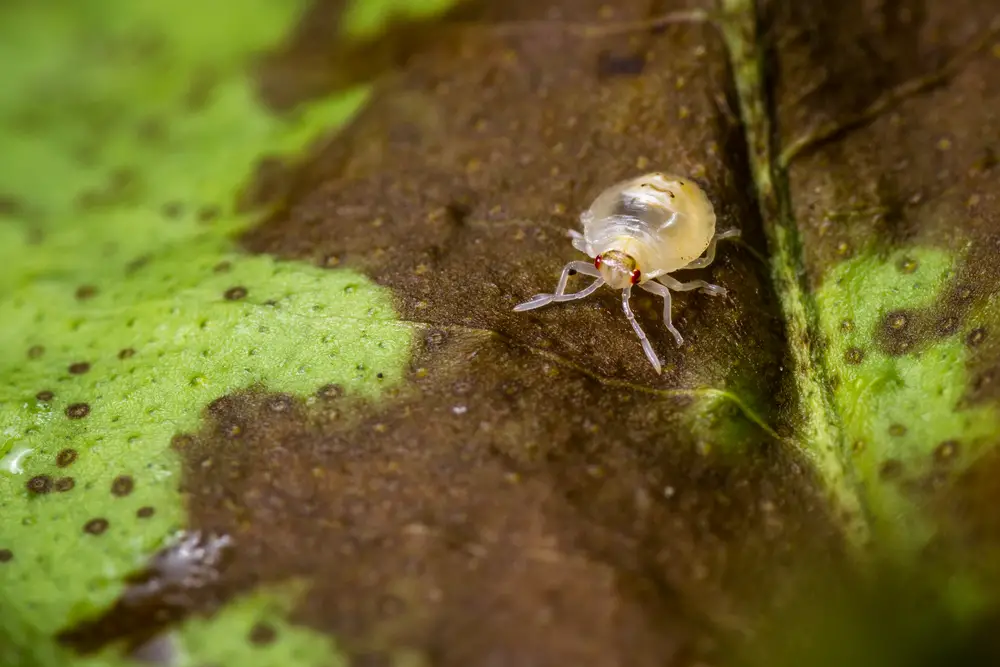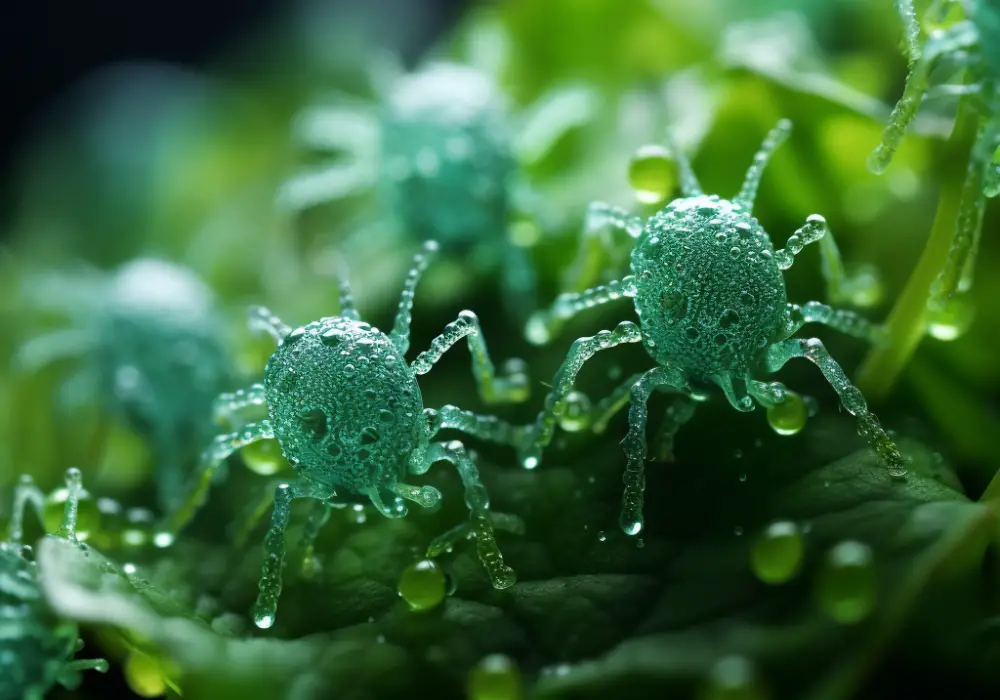Spider mites are tiny pests that can cause significant damage to plants by feeding on their sap.
They are known to infest a wide range of plants, including vegetables, fruits, and ornamental plants.
Quick Answer:
Spider mites can last days to weeks without food, depending on species and conditions. While they can endure short food shortages, their growth and reproduction diminish. Their tenacity makes them formidable pests in gardens and greenhouses, necessitating vigilant management.
Spider mites are known to be resilient pests that can survive in a variety of conditions.
The species of spider mite, the temperature, and the humidity levels are all factors that can affect how long spider mites can survive without food.
Understanding Spider Mites
Spider mites are tiny arachnids that belong to the Tetranychidae family. They are related to spiders and ticks and are known for their ability to cause significant damage to plants.
Spider mites are typically red, green, or yellow in color and have eight legs, just like other arachnids.
Spider mites are translucent, which makes them difficult to spot with the naked eye. They are also incredibly small, measuring less than 1mm in length. Despite their size, spider mites have a significant impact on the health of plants, as they feed on the sap of leaves and other plant tissues.

Spider mites are known for their ability to reproduce rapidly, with females laying hundreds of eggs in their lifetime. These eggs hatch into larvae, which then develop into adult spider mites. Spider mites can survive for up to two weeks without food, but they prefer to feed regularly to ensure their survival.
There are several different types of spider mites, each with their own unique characteristics. Some spider mites prefer specific types of plants, while others are more generalist feeders.
Understanding the type of spider mite that is affecting your plants can help you develop an effective control strategy.
The Life Cycle of Spider Mites
Spider mites are tiny arachnids that feed on the sap of plants. They reproduce quickly and can cause significant damage to crops and gardens if not controlled. Understanding the life cycle of spider mites is essential to managing their populations effectively.
Eggs
The life cycle of spider mites begins with eggs. Female spider mites lay their eggs on the underside of leaves, where they are protected from predators and environmental factors.
The eggs are small, round, and translucent, making them difficult to see with the naked eye. Depending on the species, they can hatch in as little as three days.
Hatch
After hatching, spider mites enter the larval stage. They are six-legged and have a round body with a small head. During this stage, they feed on plant sap and molt several times before becoming nymphs.
Nymphs
Nymphs are similar in appearance to adults but smaller. They have eight legs and are more mobile than larvae. They continue to feed on plant sap and molt several times before reaching adulthood.
Male and Female Spider Mites
Adult spider mites are sexually dimorphic, meaning males and females have different physical characteristics. Males are smaller and have a pointed abdomen, while females are larger and have a rounder abdomen.
Female spider mites can lay up to 100 eggs in their lifetime, which can range from a few weeks to several months, depending on the species.
Lifespan
The lifespan of spider mites varies depending on the species and environmental conditions. On average, they can live for two to four weeks. However, some species can survive for up to six months without food, making them difficult to control.
Dormant
Spider mites can enter a dormant state known as diapause during unfavorable conditions such as low temperatures or drought. During this time, they stop feeding and reproducing, conserving their energy until conditions improve.
Life Cycle
The life cycle of spider mites can be completed in as little as one week under ideal conditions. However, it can take up to a month or longer if conditions are unfavorable.
Understanding the life cycle of spider mites is crucial to managing their populations effectively and preventing damage to crops and gardens.
Feeding Habits of Spider Mites

Spider mites are tiny arachnids that feed on plants, specifically on the sap of leaves. They are known to be one of the most destructive pests in agriculture, causing significant damage to crops and ornamental plants.
Spider mites are not picky eaters, and they can feed on a wide range of plants, including fruits, vegetables, and flowers.
Spider mites feed by piercing the plant’s cells and sucking out the sap, which contains water, sugars, and other nutrients. They use their sharp mouthparts to puncture the plant’s epidermis and suck out the contents.
Spider mites are capable of digesting proteins, but they primarily feed on carbohydrates and sugars found in the sap.
Spider mites can survive for several days without food, but they require water to survive. They can absorb moisture from the air or the plant’s leaves. However, if the plant is under stress or drought, spider mites may not find enough water to survive.
Spider mites are known to be opportunistic feeders, and they can switch to a different plant species if their preferred host plant is not available. They are also capable of adapting to the plant’s defenses, such as producing more sap or changing the chemical composition of the sap.
Signs of Spider Mite Infestation
Spider mites are tiny pests that can cause significant damage to plants. They can be challenging to detect because of their small size, but there are a few signs that can indicate the presence of an infestation.
One of the most common signs of spider mite infestation is yellow spots on the leaves of affected plants. These spots are caused by the mites sucking the sap out of the leaves. If left untreated, the leaves will eventually turn brown and fall off the plant.
Another sign of spider mite infestation is the presence of webs or webbing on the affected plants. These webs are made of silk and are used by the mites to protect themselves from predators and to help them move around the plant.
In severe cases, the leaves of affected plants may become covered in silk webs. This can make it difficult for the plant to photosynthesize and can eventually lead to the death of the plant.
Spider Mites and Their Preferred Conditions
Spider mites are tiny pests that belong to the arachnid family. They are common in both indoor and outdoor plants and can cause significant damage if not controlled. These pests prefer warm and dry conditions, making them more active during the summer months.
Spider mites thrive in a humid environment, which is why they are commonly found in greenhouses and indoor plants with poor ventilation. They are attracted to plants that are weak or stressed, making them more susceptible to infestations.
Environmental conditions play a significant role in the survival and reproduction of spider mites. They can survive without food for up to two weeks, making it essential to control their population before they cause significant damage.
Indoor plants are particularly vulnerable to spider mite infestations due to the controlled environment and lack of natural predators. Outdoor plants, on the other hand, have a better chance of natural control due to the presence of beneficial insects.
Natural Predators of Spider Mites
Spider mites have a variety of natural predators that help to keep their populations in check. These predators include:
- Ladybugs: Ladybugs are one of the most well-known natural predators of spider mites. They feed on both the eggs and adult mites.
- Lacewings: Lacewing larvae are voracious predators of spider mites. They feed on the eggs and immature mites.
- Predatory mites: There are several species of predatory mites that feed on spider mites. These include Phytoseiulus persimilis, Amblyseius andersoni, and Neoseiulus californicus.
- Minute pirate bugs: These tiny insects feed on a variety of pests, including spider mites.
- Assassin bugs: Assassin bugs are generalist predators that feed on a variety of insects, including spider mites.
In addition to these predators, there are also a number of parasitic wasps that lay their eggs inside spider mite eggs. When the wasp larvae hatch, they feed on the spider mite eggs, effectively killing them.
Spider Mites and Plant Damage
Spider mites are tiny pests that can cause significant damage to plants. They feed on the sap of plants by piercing the leaves with their mouthparts, which can result in the yellowing and drying of leaves.
Spider mites can be a problem for houseplants, gardens, vegetables, flowers, shrubs, oak, spruce, cucumber, squash, tomato, junipers, marigolds, and strawberries.
Spider mites reproduce quickly, and a single female can lay up to 100 eggs in her lifetime. Their life cycle is short, and they can complete a generation in as little as a week in warm weather. Spider mites can survive without food for up to two weeks, but they prefer to feed every three to four days.
When spider mites infest a plant, they can cause extensive damage, which can lead to stunted growth and even death. The damage caused by spider mites can be mistaken for other plant diseases or nutrient deficiencies, making it essential to identify the pest early.
To prevent spider mites from infesting plants, it is crucial to maintain proper plant care, including regular watering, fertilization, and pruning. It is also important to monitor plants regularly for signs of spider mites and take immediate action if an infestation is detected.
Preventing and Controlling Spider Mite Infestations
Spider mites can be a nuisance to gardeners and farmers alike. Preventing and controlling spider mite infestations is the key to maintaining a healthy garden or farm. Here are some tips to help prevent and control spider mite infestations:
- Check plants regularly: Regularly inspecting plants for spider mites is an important step in preventing infestations. Look for signs of spider mites, such as webbing and yellow or brown spots on the leaves.
- Quarantine infested plants: If you find an infested plant, remove it from the rest of the plants and quarantine it until the infestation is under control. This will prevent the spread of spider mites to other plants.
- Keep a safe and clean environment: Spider mites thrive in hot and dry conditions. Keeping the environment cool and humid can help prevent infestations. Also, keeping the area clean and free of debris can help prevent spider mites from finding a place to hide.
- Get rid of spider mites: There are several ways to get rid of spider mites, including using insecticidal soap or neem oil. These products are safe and effective for controlling spider mites.
Treatment Options for Spider Mite Infestations
Once an infestation of spider mites has been identified, it is important to take action to control and eliminate the problem. There are several treatment options available, ranging from chemical pesticides to natural remedies.
Chemical Pesticides
Chemical pesticides are often the first line of defense against spider mites. There are several types of pesticides available, including bifenthrin, kelthane, malathion, cyfluthrin, and pyrethrum.
These pesticides can be effective in controlling spider mites, but they can also be harmful to beneficial insects and the environment.
- For use indoors and outdoors
- Can be tank mixed with other pesticides, including insect growth regulators
- Controls indoor pests including fleas, cockroaches and ants
Neem and Neem Oil
Neem is a natural pesticide that comes from the neem tree. It is safe for humans and animals, but it can be harmful to spider mites. Neem oil can be applied directly to the affected plants, and it will kill spider mites on contact.
- 100% Cold Pressed
- Pure Unrefined Neem Oil
- Premium Grade Quality
Neem oil can also be used as a preventative measure to keep spider mites from infesting plants.
Insecticidal Soap
Insecticidal soap is a natural remedy that can be used to control spider mites. It works by suffocating the mites, and it is safe for humans, animals, and the environment.
Insecticidal soap can be applied directly to the affected plants, and it should be reapplied every 7-10 days until the infestation is under control.
Oils
Horticultural oils, such as mineral oil and vegetable oil, can be used to control spider mites. These oils work by suffocating the mites, and they are safe for humans, animals, and the environment.
Oils should be applied directly to the affected plants, and they should be reapplied every 7-10 days until the infestation is under control.
Total Release Fogger
A total release fogger can be used to control spider mites in an enclosed area. The fogger releases a mist that kills spider mites on contact, and it is safe for humans, animals, and the environment.
The fogger should be used in a well-ventilated area, and all people and animals should be removed from the area before use.
Rubbing Alcohol
Rubbing alcohol can be used to control spider mites on houseplants. It should be applied directly to the affected leaves with a cotton swab or spray bottle. Rubbing alcohol can be effective in controlling spider mites, but it can also be harmful to the plant if used in excess.
Overall, there are several treatment options available for controlling spider mites. It is important to choose a treatment method that is safe for humans, animals, and the environment and to follow the instructions carefully for the best results.
Commonly Affected Plants and How to Check for Spider Mites
Spider mites are known to infest a wide range of plants, including houseplants, indoor and outdoor plants, vegetables, flowers, shrubs, oak, spruce, cucumber, squash, tomato, junipers, marigolds, strawberries, and more.
These tiny pests can cause significant damage to plants by feeding on the leaves and sucking out their sap, which can lead to yellowing, wilting, and even death of the plant.
To check for spider mites, one can use a magnifying glass to inspect the underside of the leaves for small, reddish-brown, or greenish-yellow mites, as well as their eggs and webbing.
Another way to detect spider mites is to shake the leaves over a white piece of paper and look for tiny moving dots.
Some plants are more susceptible to spider mite infestations than others. For example, houseplants such as spider plants, ivy, and palms are often targeted by spider mites.
Outdoor plants such as roses, azaleas, and fruit trees are also prone to spider mite infestations.
Spider Mites in Different Environments
Spider mites can be found in a variety of environments, including indoor plants, outdoor plants, gardens, and more. They can survive in both warm and cold climates, but their activity may slow down during the winter months.
In indoor environments, spider mites can thrive in warm and dry conditions, making them a common pest for houseplants.
They can also survive in humid environments but may not reproduce as quickly. Regularly watering and misting plants can help prevent spider mites from infesting indoor plants.
Outdoor plants and gardens can also be affected by spider mites. They are particularly prevalent in dry and dusty conditions but can also survive in humid environments.
Regular watering and maintaining a healthy environment for plants can help prevent spider mites from infesting outdoor plants and gardens.
During the winter months, spider mites can survive without food for longer periods of time. They may become less active or go into a state of hibernation but can still survive until conditions become more favorable for reproduction and feeding.
Overall, spider mites are adaptable pests that can survive in a variety of environments. Understanding their behavior and preferred conditions can help prevent infestations and keep plants healthy.




